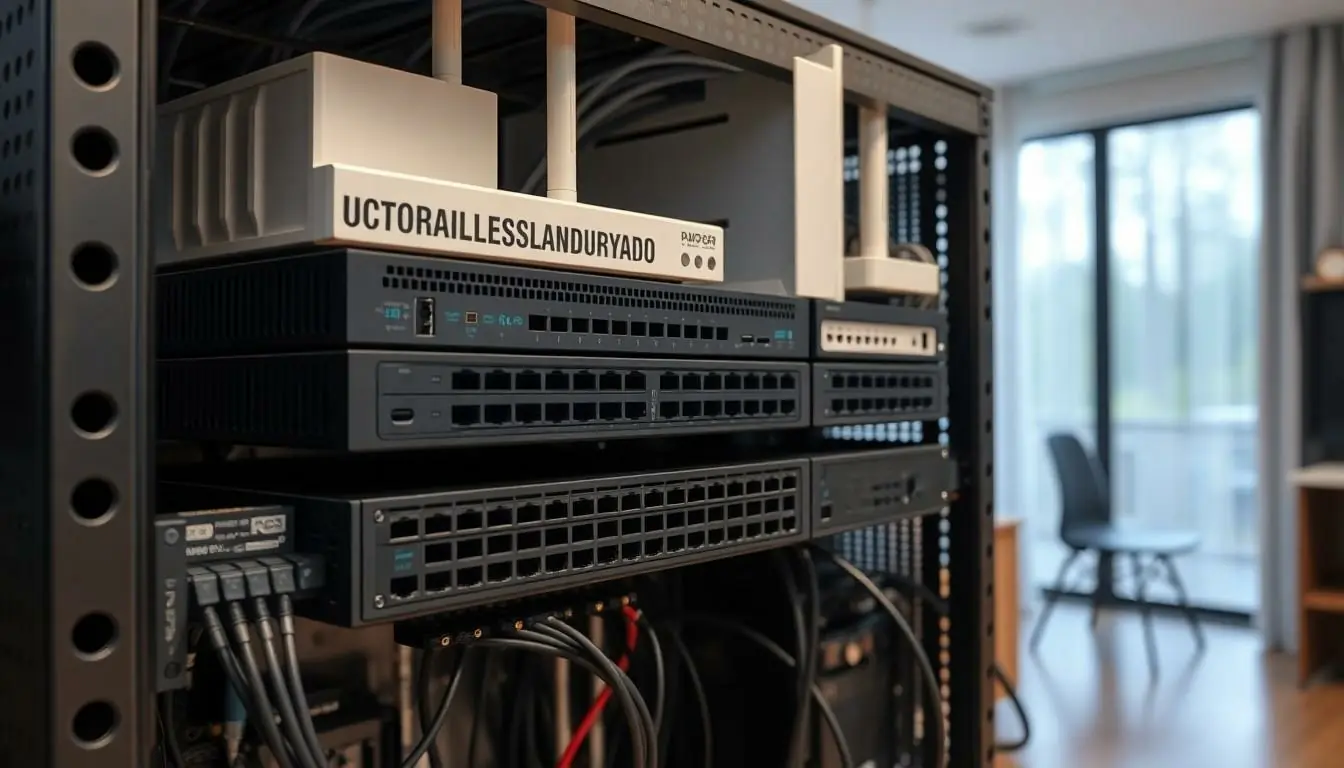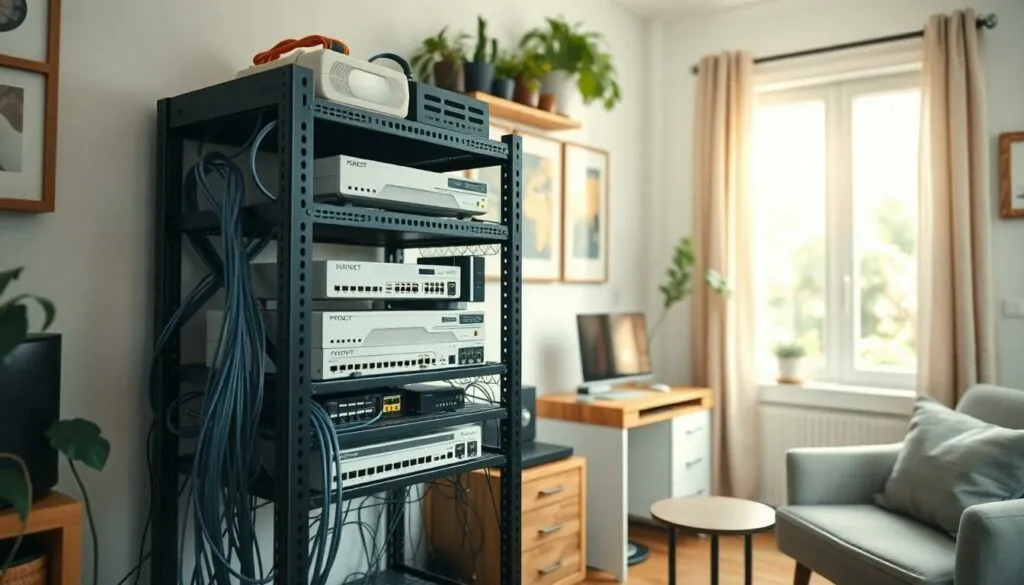In the age of smart homes and endless streaming, a reliable home network isn’t just a luxury—it’s a necessity. Enter the home networking rack, the unsung hero of modern living. Think of it as the superhero of your digital domain, keeping all those cables organized and your devices connected without turning your living room into a spaghetti factory.
Imagine a world where your Wi-Fi signal doesn’t drop during the climactic scene of your favorite show. With a home networking rack, that dream can become a reality. It’s time to say goodbye to the chaos and embrace the sleek efficiency of a well-organized network. After all, who wouldn’t want a setup that looks as good as it functions? Get ready to elevate your home networking game and enjoy seamless connectivity like never before.
Table of Contents
ToggleOverview of Home Networking Racks
Home networking racks serve as essential hubs for managing various networking equipment. These racks provide a dedicated space for routers, switches, and wireless access points, helping maintain an organized setup. With a structured configuration, users can easily access devices, reducing setup complexity.
Variety exists in home networking racks, including wall-mounted and freestanding options. Wall-mounted racks optimize space in smaller areas, while freestanding racks accommodate larger setups. Each type supports different sizes and weights of equipment, ensuring flexibility for users.
Sufficient ventilation plays a crucial role in the efficiency of a networking rack. Proper airflow prevents overheating, enhancing device performance. Many racks include built-in fans or vents to facilitate adequate cooling.
Moreover, cable management is a vital feature of home networking racks. Organized cables improve aesthetics and minimize signal interference. They reduce the likelihood of accidental disconnections or damage to equipment.
Additionally, networking racks offer scalability. As home networks expand, users can add more devices without compromising organization. Modular designs allow for future upgrades, making it easy to adapt to changing technological needs.
Security features also enhance home networking racks. Some racks include locking doors to protect devices from unauthorized access. Such measures ensure that sensitive information remains secure.
Overall, home networking racks represent a key element in establishing a reliable home network. With options for various setups, users can select a rack that meets their specific requirements. When implemented correctly, these racks contribute significantly to improved connectivity and network efficiency.
Benefits of Using a Home Networking Rack

A home networking rack provides several advantages for improved connectivity and efficiency.
Improved Organization
Organization plays a crucial role in maintaining a reliable home network. A networking rack allows devices like routers, switches, and access points to be neatly stored in one location. This arrangement minimizes clutter, making it easier to access equipment and cables as needed. Easily identifiable labels can further enhance this organization, providing clarity during maintenance or upgrades. Users often find that they can troubleshoot connections more effectively when everything is well organized, ultimately increasing the efficiency of their setup.
Enhanced Cooling
Cooling is essential for device longevity and performance. A home networking rack often features built-in ventilation systems designed to prevent overheating. Proper airflow ensures that devices stay cool during operation, reducing the risk of failure due to heat. Many racks come with additional slots for fans or support for passive cooling methods, allowing for optimal temperature management. Maintaining a cool environment for networking equipment can significantly improve network reliability and speed.
Future-Proofing Your Network
Future-proofing a network is vital for adapting to technological advancements. A home networking rack provides scalability, accommodating additional devices as needs grow. Whether adding new access points for expanding Wi-Fi coverage or integrating smart home devices, a well-planned rack setup supports this flexibility. Users can easily customize their racks with modular components, allowing for upgrades without extensive overhauls. Anticipating future needs can save time and money while ensuring the network remains robust and efficient.
Types of Home Networking Racks
Home networking racks come in various types, each catering to specific needs and environments. Understanding these options helps optimize space and performance.
Wall-Mounted Racks
Wall-mounted racks maximize vertical space and fit well in smaller areas. They’re ideal for home offices or utility rooms where floor space is limited. With easy access to equipment, these racks simplify maintenance tasks. Built-in ventilation promotes airflow, crucial for preventing overheating among devices. Some models offer adjustable shelves, accommodating various equipment sizes. Security features, such as locking doors, help protect devices from unauthorized access. Users appreciate how wall-mounted racks neatly consolidate network equipment without clutter.
Floor-Standing Racks
Floor-standing racks provide ample space for larger setups, commonly used in dedicated home network rooms. These units support considerable weight, making them suitable for numerous devices like switches, routers and servers. Their design allows for efficient cable management, reducing tangles and improving aesthetics. Some floor-standing options include adjustable shelving, providing customization for different equipment heights. Typically, they offer excellent ventilation to maintain optimal performance of devices. With the capability to grow alongside evolving technology needs, these racks help users maintain a flexible and organized networking solution.
Key Features to Consider
Selecting the right home networking rack requires attention to several critical features. These features ensure optimal performance, organization, and future adaptability.
Size and Height
Space availability dictates the choice of size and height for a networking rack. A compact rack suits smaller areas, while larger spaces can accommodate a tall or wide unit. The dimensions affect how many devices fit and how easy maintenance becomes. Consider the equipment quantity before selecting a rack. A well-sized rack optimizes space without overcrowding.
Material and Build Quality
Material and build quality influence longevity and durability in home networking racks. Steel construction often offers greater strength and stability compared to plastic alternatives. High-quality racks endure the weight of heavy equipment and resist wear over time. Look for racks with powder-coated finishes to prevent rust and scratches. The choice of materials affects aesthetics, as well as the overall longevity of the setup.
Compatibility with Equipment
Compatibility with existing equipment is crucial when choosing a home networking rack. Various networking devices such as routers, switches, and access points come in different sizes. Ensuring that the rack can accommodate these devices prevents issues with mounting and accessibility. Check the unit’s rack units (U) measurement to confirm it aligns with device dimensions. A compatible rack simplifies integrations and enhancements as network needs grow.
Installation and Setup Tips
Proper installation and setup of a home networking rack ensures optimal performance and accessibility for equipment. Focusing on location and cable management significantly simplifies ongoing maintenance.
Choosing the Right Location
Selecting the right location for a home networking rack plays a critical role in overall functionality. Prefer spaces with good airflow to prevent overheating. It’s advisable to place the rack near existing power and network connections for easier access. Ensure the chosen area is easily accessible for maintenance or adjustments. Consider proximity to devices like routers and switches to minimize cable lengths, enhancing signal integrity.
Proper Wiring and Cable Management
Effective wiring and cable management contribute to both performance and aesthetics. Start by organizing cables with labeled ties or sleeves to avoid confusion. Discard any excess length that may clutter the space. Utilize rack-mounted cable management solutions, such as horizontal and vertical cable organizers, to maintain tidiness. Ensure cables are routed away from heat sources to prevent damage. Keeping network cables separated from power cables minimizes electromagnetic interference, leading to improved network reliability.
A home networking rack is an essential investment for anyone looking to enhance their smart home experience. By providing organization and scalability, it ensures that the network remains efficient and adaptable to future needs. The right rack not only improves connectivity but also simplifies maintenance, making it easier to troubleshoot issues when they arise.
With options available for various spaces and requirements, homeowners can find a suitable solution that fits their unique setups. Prioritizing features like ventilation and cable management further contributes to a well-functioning network. Ultimately, a well-selected networking rack transforms a chaotic setup into a streamlined hub, paving the way for a seamless digital lifestyle.




